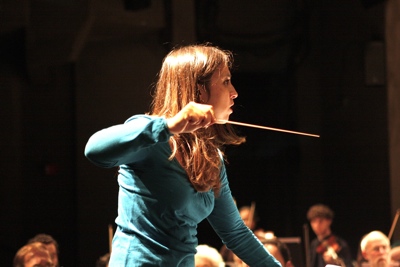Carneiro essays challenging program
The Berkeley Symphony, under the baton of Joana Carneiro, ended their season at Zellerbach Hall last Thursday, April 1.
Magic can happen when all the ingredients work together, gelling into something whole and unexpected: a spell.
But if the recipe should go awry?
Excellent musicians, awesome soprano, inspired conductor and grand venue had some magical moments, but did not quite mesh Thursday night for Samuel Barber’s Knoxville: Summer of 1915. Set to James Agee’s prose poem, a child’s bright memory of a twilit lawn, Barber captures the slow wistful text with spare orchestration and lyrical line.
Soprano Jessica Rivera, this season’s featured artist, offered up sweet vowels simmered in a gorgeous vibrato, and she is certainly an artist to watch. But Agee requires something else, a talky quality with a broader American lilt.
Zellerbach’s concrete expanses tend to swallow up that more intimate approach, so very few artists could have rendered that speaky quality, or delivered the child-like wonder that Leontyne Price famously brought to the piece.
Written for chamber orchestra, the full orchestra often trod on Rivera’s hem, crowding her quieter phrases. But some moments were worth waiting for, and the ending was exquisite.
The ambitious program started with Con brio, Jörg Widman’s modern homage—or deconstruction—of Beethoven’s symphonies.

Conductor Joana Carneiro addressed us from the podium. “If I had to come up with a name for this program it would be ‘Inspiration.’ Con brio was written by Widman for Beethoven’s 7 and 8, and is very humorous. I heard the timpani described as a mouse with very long nails inside a dryer.”
Con brio had a dry wit and a dry sound. Plucked strings and the clack of stick on drum rim shaped the language, with phrases emphatic and concise.
Widman, a recent force in German musical language, composes to very high standards, opening with unison pizzicatos that are nearly impossible to pull off. The typical three rehearsals that most orchestras are paid for could hardly do this justice, but the musicians conveyed the drama and wry struggle nonetheless.
Though complex and full of contemporary rhetoric, the music was curiously easy on the ears. Beethoven quotes appeared in the French horns, and trumpets joined with a disregard for key or tempo. An audience member described it as “Beethoven through a meat grinder…but I liked it.”
Widman ends with a clatter of falling sticks and three irreverent toots, a play on his icon’s massive finales.
After dessert and soup came the meat and potatoes, Brahms’ Symphony No. 1. Intimidated by Beethoven’s wit and power, Brahms sketched out parts of his symphony for over twenty years before finally publishing it in 1876.
“Brahms’ inspiration was again Beethoven, but the lush sound could only come from Brahms,” commented Carneiro. And so it was. The opening was electric, with the full orchestra climbing heavily up a winding scale to a timpani heartbeat.
In the stately Andante sostenuto one senses Brahms’ feel for natural forces, seasons dying into each other. A violin solo brought out the melancholy sweetness of concertmaster Franklyn D’Antonio’s high bowing.
The final movement is majestic and serene, quoting Beethoven’s 9th in lush notes that subside before they can resolve into Beethoven’s chiseled phrases. But after circling the wagons Brahms gallops into the finale, and then restates the theme in big slow chords.
The Berkeley Symphony lingered and flowed, romantic and urgent, a satisfying close to the season.
Underscoring the success of their first joint year, Carneiro toured the orchestra, affectionately gesturing each performer to his or her feet as the audience applauded.
Their next season promises equally adventurous.
—Adam Broner
Originally published in the Piedmont Post.
Photo of Joana Carneiro in rehearsal, photo by Marshall Berman
